Ecm SUZUKI SWIFT 2000 1.G RG413 Service Repair Manual
[x] Cancel search | Manufacturer: SUZUKI, Model Year: 2000, Model line: SWIFT, Model: SUZUKI SWIFT 2000 1.GPages: 698, PDF Size: 16.01 MB
Page 432 of 698
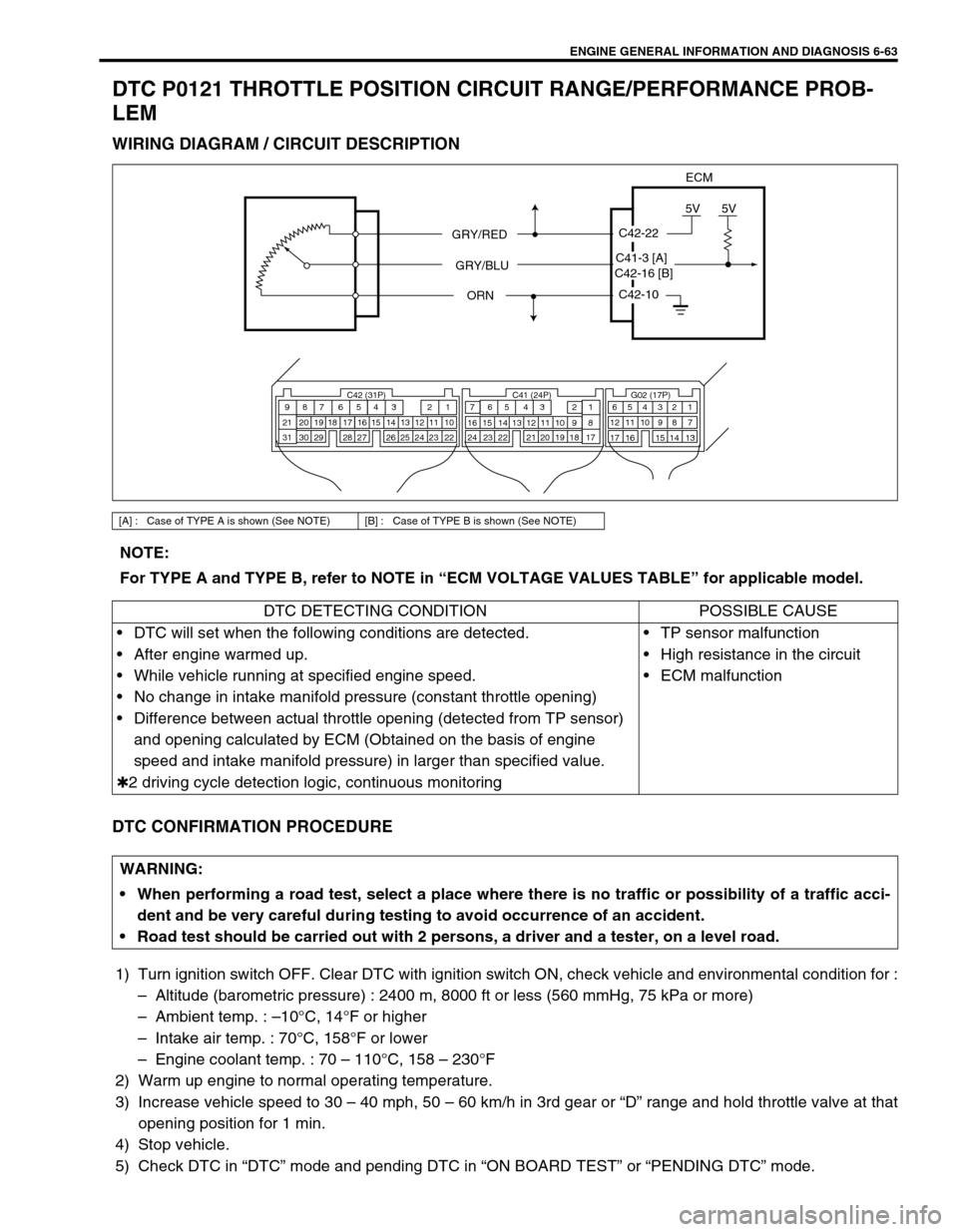
ENGINE GENERAL INFORMATION AND DIAGNOSIS 6-63
DTC P0121 THROTTLE POSITION CIRCUIT RANGE/PERFORMANCE PROB-
LEM
WIRING DIAGRAM / CIRCUIT DESCRIPTION
DTC CONFIRMATION PROCEDURE
1) Turn ignition switch OFF. Clear DTC with ignition switch ON, check vehicle and environmental condition for :
–Altitude (barometric pressure) : 2400 m, 8000 ft or less (560 mmHg, 75 kPa or more)
–Ambient temp. : –10°C, 14°F or higher
–Intake air temp. : 70°C, 158°F or lower
–Engine coolant temp. : 70 – 110°C, 158 – 230°F
2) Warm up engine to normal operating temperature.
3) Increase vehicle speed to 30 – 40 mph, 50 – 60 km/h in 3rd gear or “D” range and hold throttle valve at that
opening position for 1 min.
4) Stop vehicle.
5) Check DTC in “DTC” mode and pending DTC in “ON BOARD TEST” or “PENDING DTC” mode.
[A] : Case of TYPE A is shown (See NOTE) [B] : Case of TYPE B is shown (See NOTE)
C42-10
C42-22
5V5V
ECM
GRY/RED
GRY/BLU
ORN
C42 (31P) C41 (24P) G02 (17P)1 2 3 4 5 6 7 8 9
10 11 12 13 14 15 16 17 18 19 20 21
22 23 24 25 26 28 27 29 30 315 6
1 2 3 4 5 6 7
11 12
9 10 11 13 12 14 15 16
16 171 2
7 8
13 14 3 4
9 10
15 17 188
19 20 21 22 23 24
C42-16 [B]C41-3 [A]
NOTE:
For TYPE A and TYPE B, refer to NOTE in “ECM VOLTAGE VALUES TABLE” for applicable model.
DTC DETECTING CONDITION POSSIBLE CAUSE
DTC will set when the following conditions are detected.
After engine warmed up.
While vehicle running at specified engine speed.
No change in intake manifold pressure (constant throttle opening)
Difference between actual throttle opening (detected from TP sensor)
and opening calculated by ECM (Obtained on the basis of engine
speed and intake manifold pressure) in larger than specified value.
✱2 driving cycle detection logic, continuous monitoringTP sensor malfunction
High resistance in the circuit
ECM malfunction
WARNING:
When performing a road test, select a place where there is no traffic or possibility of a traffic acci-
dent and be very careful during testing to avoid occurrence of an accident.
Road test should be carried out with 2 persons, a driver and a tester, on a level road.
Page 433 of 698
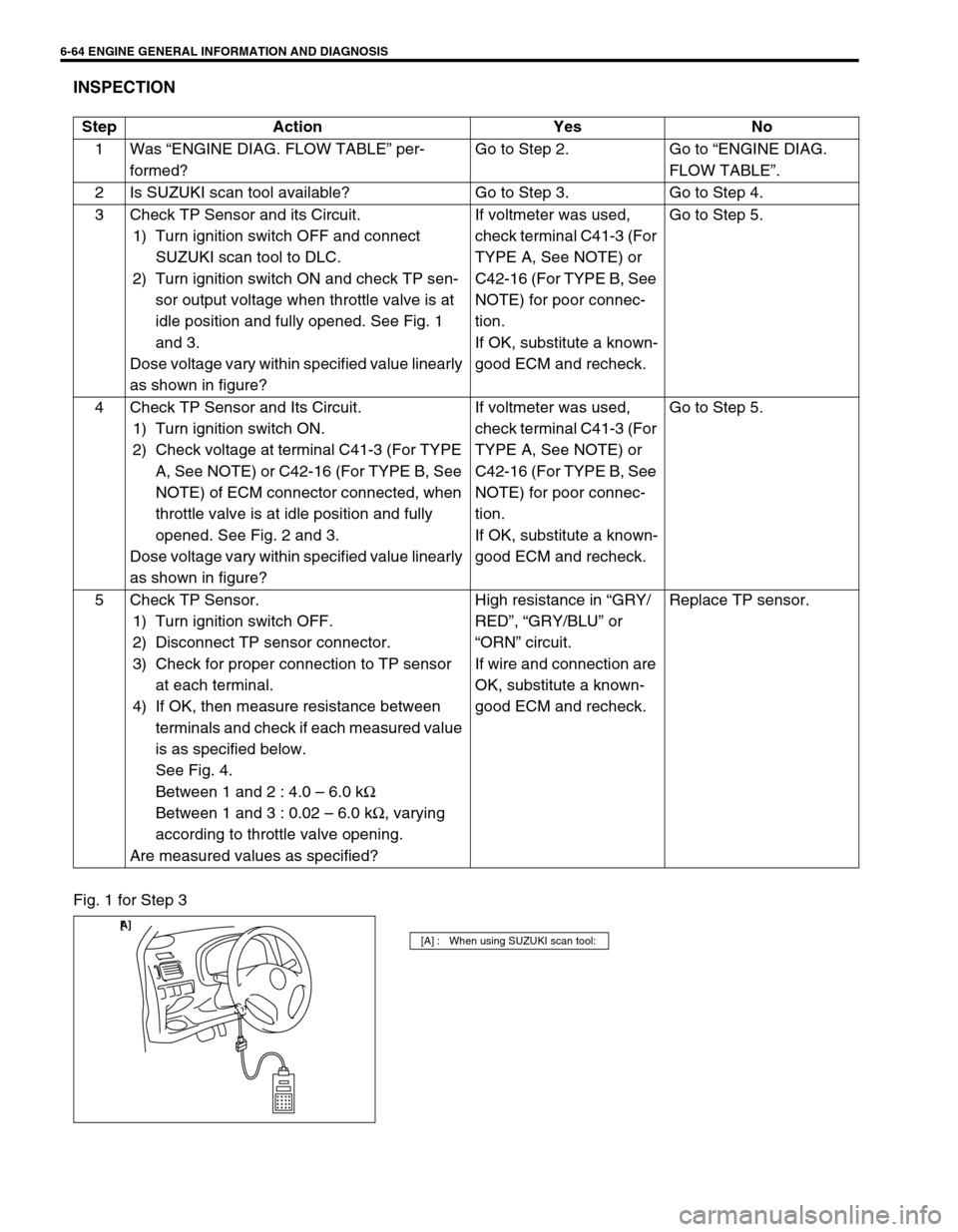
6-64 ENGINE GENERAL INFORMATION AND DIAGNOSIS
INSPECTION
Fig. 1 for Step 3Step Action Yes No
1Was “ENGINE DIAG. FLOW TABLE” per-
formed?Go to Step 2. Go to “ENGINE DIAG.
FLOW TABLE”.
2 Is SUZUKI scan tool available? Go to Step 3. Go to Step 4.
3 Check TP Sensor and its Circuit.
1) Turn ignition switch OFF and connect
SUZUKI scan tool to DLC.
2) Turn ignition switch ON and check TP sen-
sor output voltage when throttle valve is at
idle position and fully opened. See Fig. 1
and 3.
Dose voltage vary within specified value linearly
as shown in figure?If voltmeter was used,
check terminal C41-3 (For
TYPE A, See NOTE) or
C42-16 (For TYPE B, See
NOTE) for poor connec-
tion.
If OK, substitute a known-
good ECM and recheck.Go to Step 5.
4 Check TP Sensor and Its Circuit.
1) Turn ignition switch ON.
2) Check voltage at terminal C41-3 (For TYPE
A, See NOTE) or C42-16 (For TYPE B, See
NOTE) of ECM connector connected, when
throttle valve is at idle position and fully
opened. See Fig. 2 and 3.
Dose voltage vary within specified value linearly
as shown in figure?If voltmeter was used,
check terminal C41-3 (For
TYPE A, See NOTE) or
C42-16 (For TYPE B, See
NOTE) for poor connec-
tion.
If OK, substitute a known-
good ECM and recheck.Go to Step 5.
5 Check TP Sensor.
1) Turn ignition switch OFF.
2) Disconnect TP sensor connector.
3) Check for proper connection to TP sensor
at each terminal.
4) If OK, then measure resistance between
terminals and check if each measured value
is as specified below.
See Fig. 4.
Between 1 and 2 : 4.0 – 6.0 kΩ
Between 1 and 3 : 0.02 – 6.0 kΩ, varying
according to throttle valve opening.
Are measured values as specified?High resistance in “GRY/
RED”, “GRY/BLU” or
“ORN” circuit.
If wire and connection are
OK, substitute a known-
good ECM and recheck.Replace TP sensor.
[A] : When using SUZUKI scan tool:
[ A]
Page 435 of 698
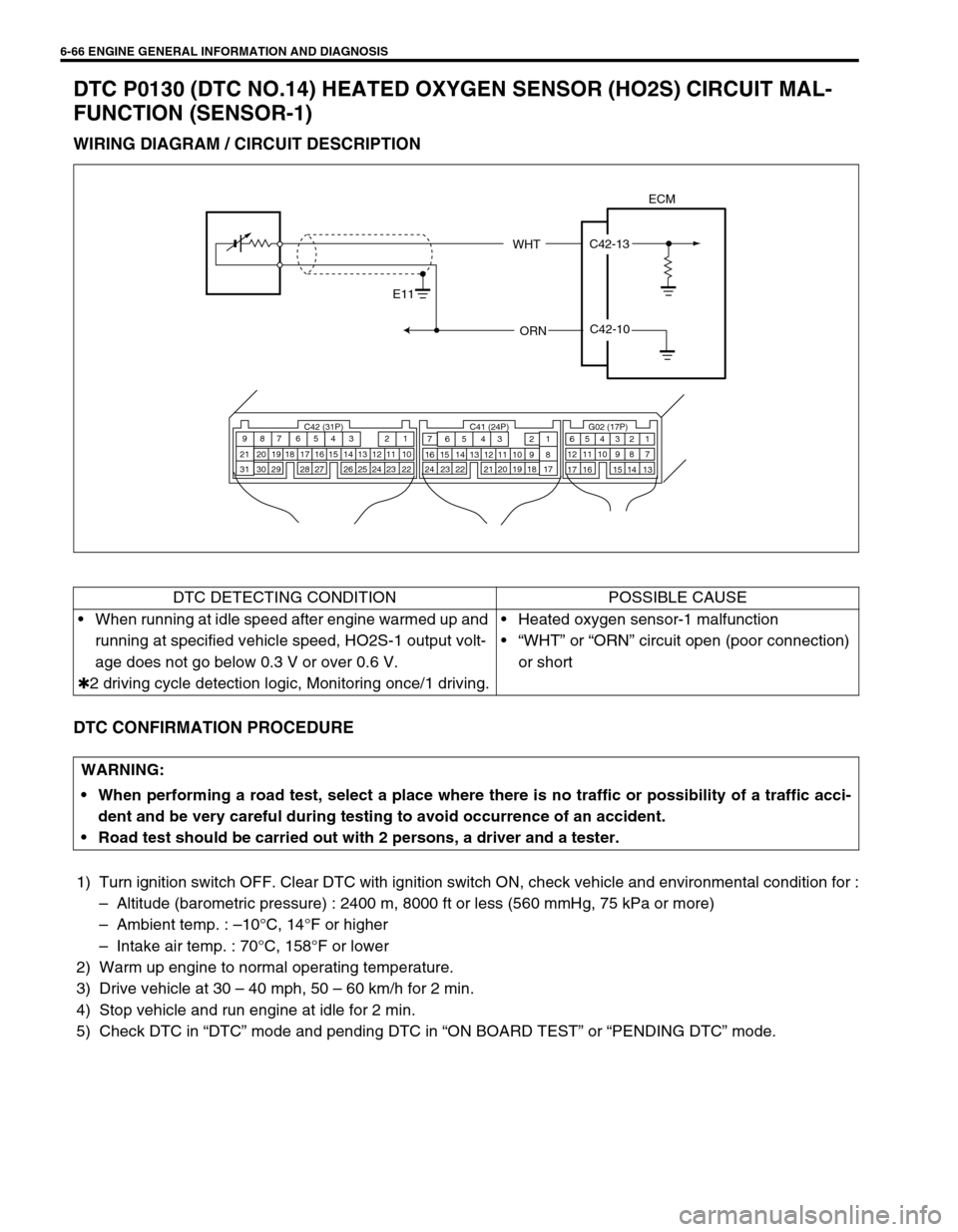
6-66 ENGINE GENERAL INFORMATION AND DIAGNOSIS
DTC P0130 (DTC NO.14) HEATED OXYGEN SENSOR (HO2S) CIRCUIT MAL-
FUNCTION (SENSOR-1)
WIRING DIAGRAM / CIRCUIT DESCRIPTION
DTC CONFIRMATION PROCEDURE
1) Turn ignition switch OFF. Clear DTC with ignition switch ON, check vehicle and environmental condition for :
–Altitude (barometric pressure) : 2400 m, 8000 ft or less (560 mmHg, 75 kPa or more)
–Ambient temp. : –10°C, 14°F or higher
–Intake air temp. : 70°C, 158°F or lower
2) Warm up engine to normal operating temperature.
3) Drive vehicle at 30 – 40 mph, 50 – 60 km/h for 2 min.
4) Stop vehicle and run engine at idle for 2 min.
5) Check DTC in “DTC” mode and pending DTC in “ON BOARD TEST” or “PENDING DTC” mode.
ECM
WHT
ORNC42-10 C42-13
E11
C42 (31P) C41 (24P) G02 (17P)1 2 3 4 5 6 7 8 9
10 11 12 13 14 15 16 17 18 19 20 21
22 23 24 25 26 28 27 29 30 315 6
1 2 3 4 5 6 7
11 12
9 10 11 13 12 14 15 16
16 171 2
7 8
13 14 3 4
9 10
15 17 188
19 20 21 22 23 24
DTC DETECTING CONDITION POSSIBLE CAUSE
When running at idle speed after engine warmed up and
running at specified vehicle speed, HO2S-1 output volt-
age does not go below 0.3 V or over 0.6 V.
✱2 driving cycle detection logic, Monitoring once/1 driving.Heated oxygen sensor-1 malfunction
“WHT” or “ORN” circuit open (poor connection)
or short
WARNING:
When performing a road test, select a place where there is no traffic or possibility of a traffic acci-
dent and be very careful during testing to avoid occurrence of an accident.
Road test should be carried out with 2 persons, a driver and a tester.
Page 439 of 698
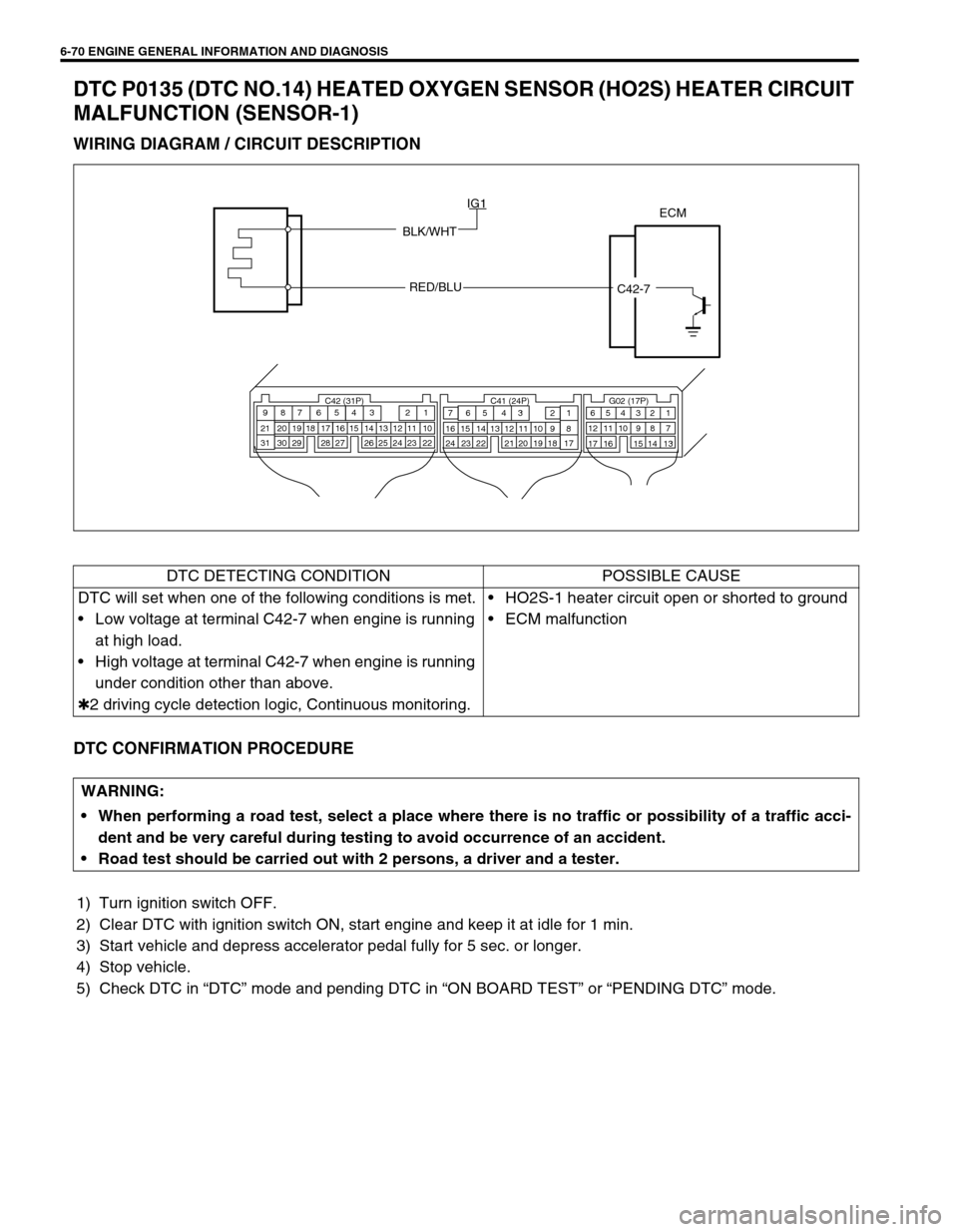
6-70 ENGINE GENERAL INFORMATION AND DIAGNOSIS
DTC P0135 (DTC NO.14) HEATED OXYGEN SENSOR (HO2S) HEATER CIRCUIT
MALFUNCTION (SENSOR-1)
WIRING DIAGRAM / CIRCUIT DESCRIPTION
DTC CONFIRMATION PROCEDURE
1) Turn ignition switch OFF.
2) Clear DTC with ignition switch ON, start engine and keep it at idle for 1 min.
3) Start vehicle and depress accelerator pedal fully for 5 sec. or longer.
4) Stop vehicle.
5) Check DTC in “DTC” mode and pending DTC in “ON BOARD TEST” or “PENDING DTC” mode.
ECM
BLK/WHT
RED/BLU
C42-7 IG1
C42 (31P) C41 (24P) G02 (17P)1 2 3 4 5 6 7 8 9
10 11 12 13 14 15 16 17 18 19 20 21
22 23 24 25 26 28 27 29 30 315 6
1 2 3 4 5 6 7
11 12
9 10 11 13 12 14 15 16
16 171 2
7 8
13 14 3 4
9 10
15 17 188
19 20 21 22 23 24
DTC DETECTING CONDITION POSSIBLE CAUSE
DTC will set when one of the following conditions is met.
Low voltage at terminal C42-7 when engine is running
at high load.
High voltage at terminal C42-7 when engine is running
under condition other than above.
✱2 driving cycle detection logic, Continuous monitoring.HO2S-1 heater circuit open or shorted to ground
ECM malfunction
WARNING:
When performing a road test, select a place where there is no traffic or possibility of a traffic acci-
dent and be very careful during testing to avoid occurrence of an accident.
Road test should be carried out with 2 persons, a driver and a tester.
Page 440 of 698
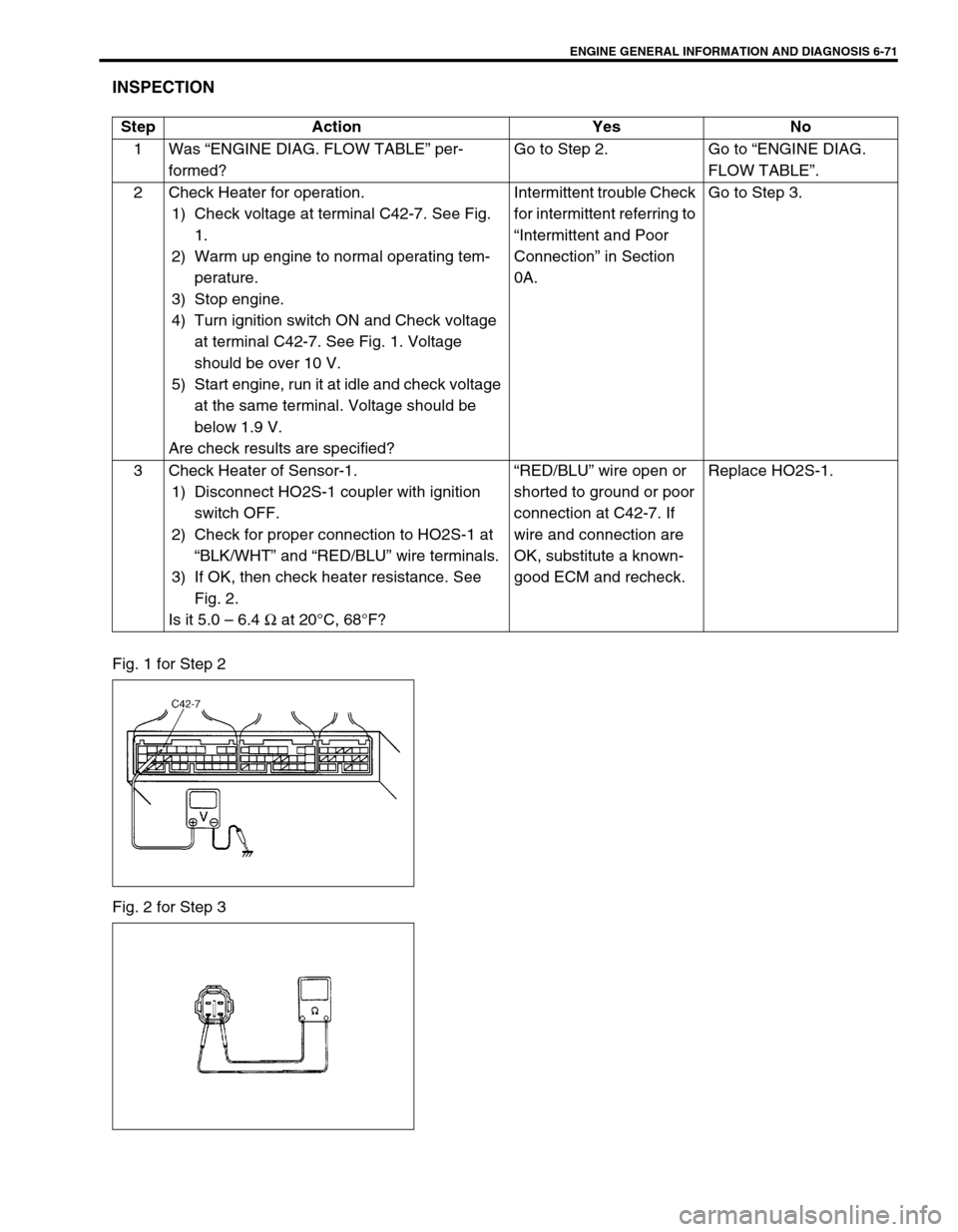
ENGINE GENERAL INFORMATION AND DIAGNOSIS 6-71
INSPECTION
Fig. 1 for Step 2
Fig. 2 for Step 3Step Action Yes No
1Was “ENGINE DIAG. FLOW TABLE” per-
formed?Go to Step 2. Go to “ENGINE DIAG.
FLOW TABLE”.
2 Check Heater for operation.
1) Check voltage at terminal C42-7. See Fig.
1.
2) Warm up engine to normal operating tem-
perature.
3) Stop engine.
4) Turn ignition switch ON and Check voltage
at terminal C42-7. See Fig. 1. Voltage
should be over 10 V.
5) Start engine, run it at idle and check voltage
at the same terminal. Voltage should be
below 1.9 V.
Are check results are specified?Intermittent trouble Check
for intermittent referring to
“Intermittent and Poor
Connection” in Section
0A.Go to Step 3.
3 Check Heater of Sensor-1.
1) Disconnect HO2S-1 coupler with ignition
switch OFF.
2) Check for proper connection to HO2S-1 at
“BLK/WHT” and “RED/BLU” wire terminals.
3) If OK, then check heater resistance. See
Fig. 2.
Is it 5.0 – 6.4 Ω at 20°C, 68°F?“RED/BLU” wire open or
shorted to ground or poor
connection at C42-7. If
wire and connection are
OK, substitute a known-
good ECM and recheck.Replace HO2S-1.
Page 441 of 698
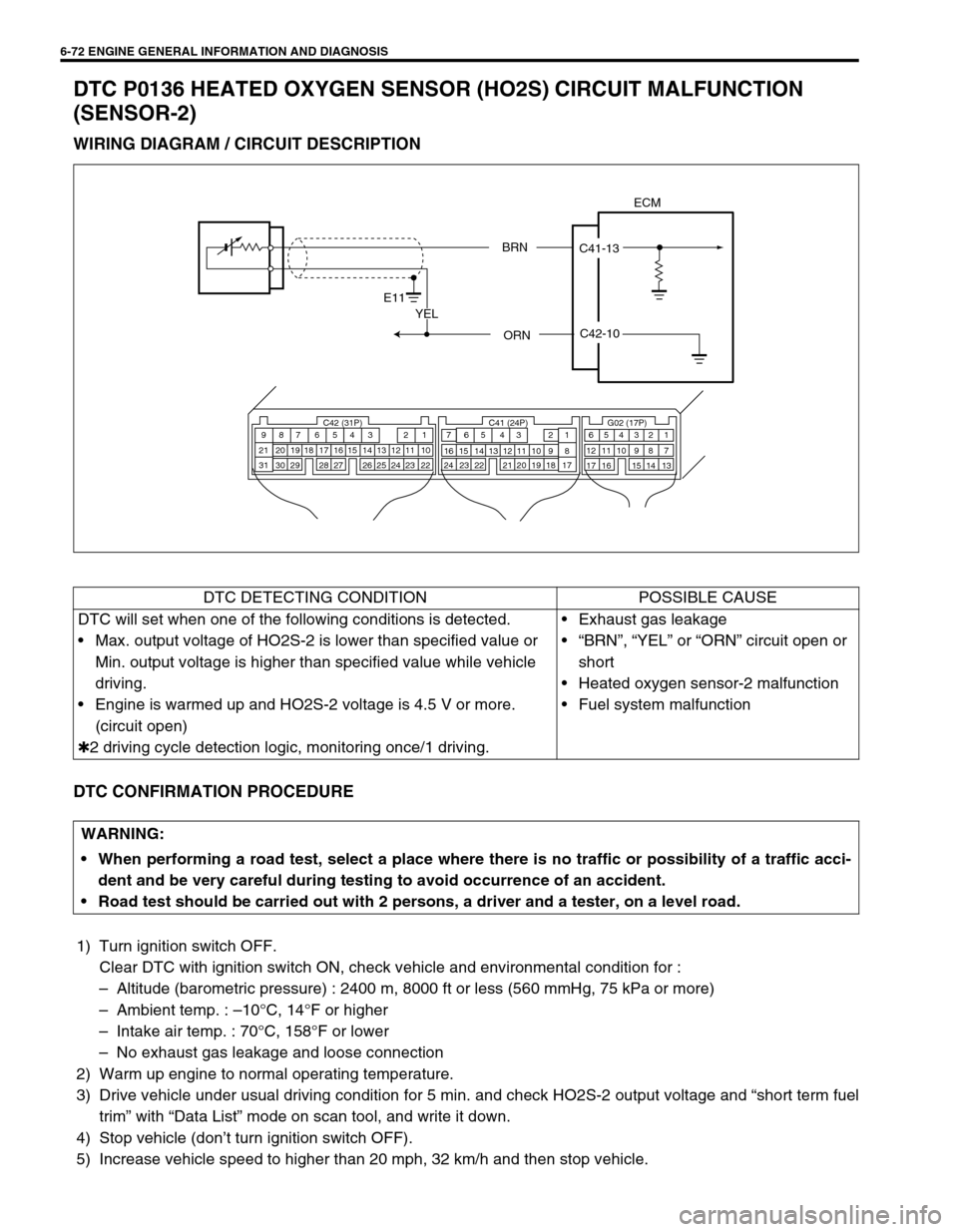
6-72 ENGINE GENERAL INFORMATION AND DIAGNOSIS
DTC P0136 HEATED OXYGEN SENSOR (HO2S) CIRCUIT MALFUNCTION
(SENSOR-2)
WIRING DIAGRAM / CIRCUIT DESCRIPTION
DTC CONFIRMATION PROCEDURE
1) Turn ignition switch OFF.
Clear DTC with ignition switch ON, check vehicle and environmental condition for :
–Altitude (barometric pressure) : 2400 m, 8000 ft or less (560 mmHg, 75 kPa or more)
–Ambient temp. : –10°C, 14°F or higher
–Intake air temp. : 70°C, 158°F or lower
–No exhaust gas leakage and loose connection
2) Warm up engine to normal operating temperature.
3) Drive vehicle under usual driving condition for 5 min. and check HO2S-2 output voltage and “short term fuel
trim” with “Data List” mode on scan tool, and write it down.
4) Stop vehicle (don’t turn ignition switch OFF).
5) Increase vehicle speed to higher than 20 mph, 32 km/h and then stop vehicle.
ECM
E11BRN
ORNC42-10 C41-13
C42 (31P) C41 (24P) G02 (17P)1 2 3 4 5 6 7 8 9
10 11 12 13 14 15 16 17 18 19 20 21
22 23 24 25 26 28 27 29 30 315 6
1 2 3 4 5 6 7
11 12
9 10 11 13 12 14 15 16
16 171 2
7 8
13 14 3 4
9 10
15 17 188
19 20 21 22 23 24
YEL
DTC DETECTING CONDITION POSSIBLE CAUSE
DTC will set when one of the following conditions is detected.
Max. output voltage of HO2S-2 is lower than specified value or
Min. output voltage is higher than specified value while vehicle
driving.
Engine is warmed up and HO2S-2 voltage is 4.5 V or more.
(circuit open)
✱2 driving cycle detection logic, monitoring once/1 driving.Exhaust gas leakage
“BRN”, “YEL” or “ORN” circuit open or
short
Heated oxygen sensor-2 malfunction
Fuel system malfunction
WARNING:
When performing a road test, select a place where there is no traffic or possibility of a traffic acci-
dent and be very careful during testing to avoid occurrence of an accident.
Road test should be carried out with 2 persons, a driver and a tester, on a level road.
Page 443 of 698
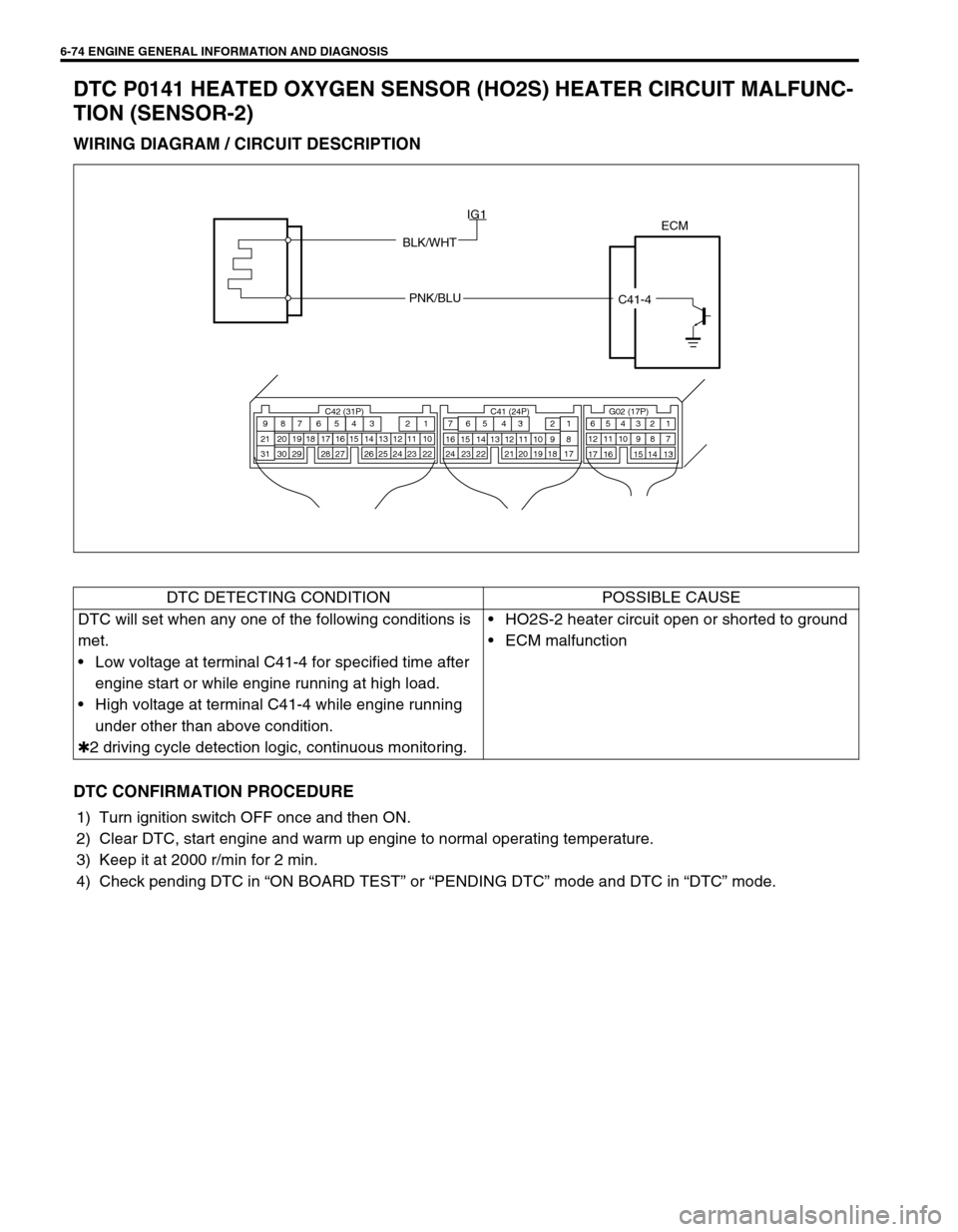
6-74 ENGINE GENERAL INFORMATION AND DIAGNOSIS
DTC P0141 HEATED OXYGEN SENSOR (HO2S) HEATER CIRCUIT MALFUNC-
TION (SENSOR-2)
WIRING DIAGRAM / CIRCUIT DESCRIPTION
DTC CONFIRMATION PROCEDURE
1) Turn ignition switch OFF once and then ON.
2) Clear DTC, start engine and warm up engine to normal operating temperature.
3) Keep it at 2000 r/min for 2 min.
4) Check pending DTC in “ON BOARD TEST” or “PENDING DTC” mode and DTC in “DTC” mode.
ECM
BLK/WHT
PNK/BLU
C41-4 IG1
C42 (31P) C41 (24P) G02 (17P)1 2 3 4 5 6 7 8 9
10 11 12 13 14 15 16 17 18 19 20 21
22 23 24 25 26 28 27 29 30 315 6
1 2 3 4 5 6 7
11 12
9 10 11 13 12 14 15 16
16 171 2
7 8
13 14 3 4
9 10
15 17 188
19 20 21 22 23 24
DTC DETECTING CONDITION POSSIBLE CAUSE
DTC will set when any one of the following conditions is
met.
Low voltage at terminal C41-4 for specified time after
engine start or while engine running at high load.
High voltage at terminal C41-4 while engine running
under other than above condition.
✱2 driving cycle detection logic, continuous monitoring.HO2S-2 heater circuit open or shorted to ground
ECM malfunction
Page 444 of 698
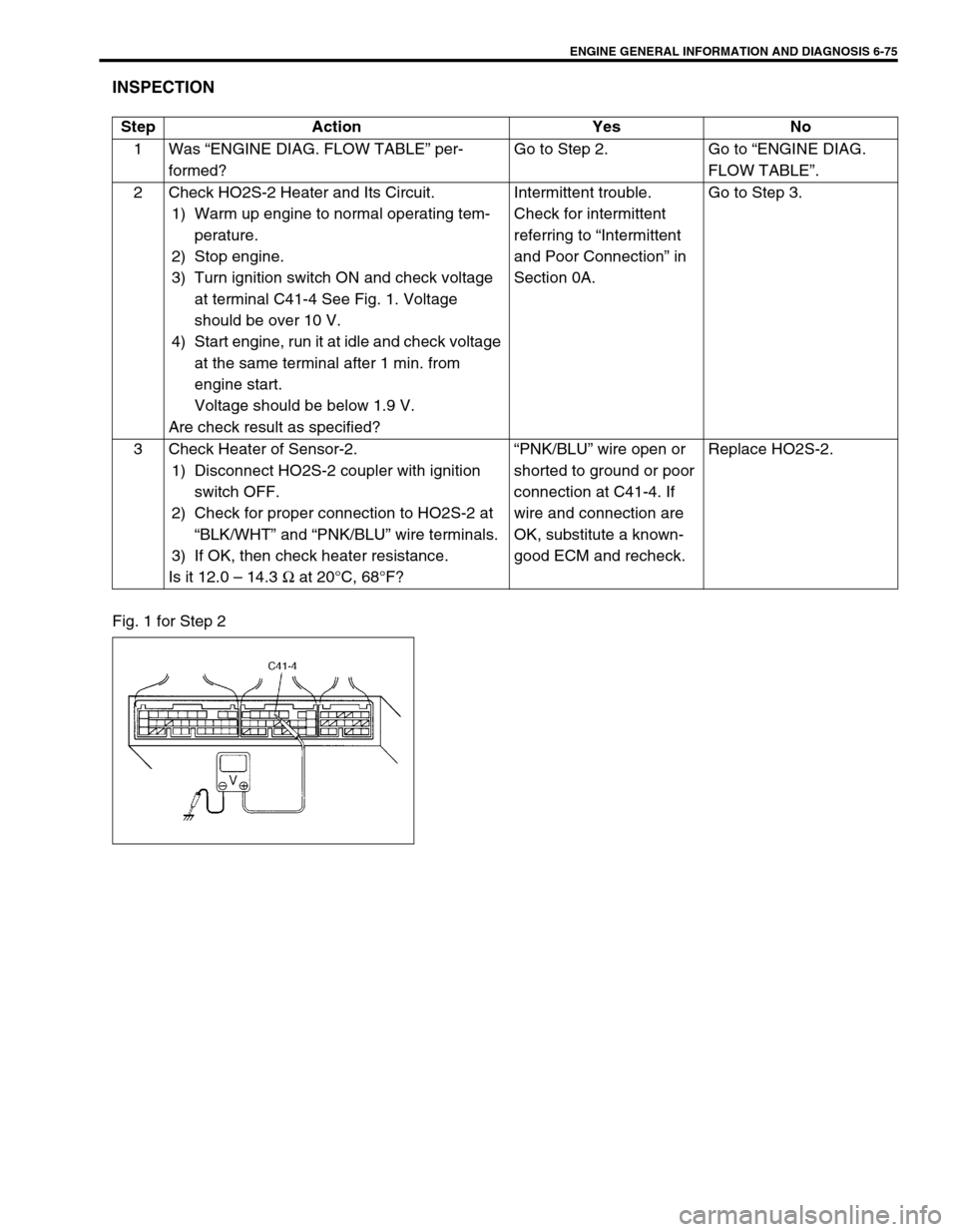
ENGINE GENERAL INFORMATION AND DIAGNOSIS 6-75
INSPECTION
Fig. 1 for Step 2Step Action Yes No
1Was “ENGINE DIAG. FLOW TABLE” per-
formed?Go to Step 2. Go to “ENGINE DIAG.
FLOW TABLE”.
2 Check HO2S-2 Heater and Its Circuit.
1) Warm up engine to normal operating tem-
perature.
2) Stop engine.
3) Turn ignition switch ON and check voltage
at terminal C41-4 See Fig. 1. Voltage
should be over 10 V.
4) Start engine, run it at idle and check voltage
at the same terminal after 1 min. from
engine start.
Voltage should be below 1.9 V.
Are check result as specified?Intermittent trouble.
Check for intermittent
referring to “Intermittent
and Poor Connection” in
Section 0A.Go to Step 3.
3 Check Heater of Sensor-2.
1) Disconnect HO2S-2 coupler with ignition
switch OFF.
2) Check for proper connection to HO2S-2 at
“BLK/WHT” and “PNK/BLU” wire terminals.
3) If OK, then check heater resistance.
Is it 12.0 – 14.3 Ω at 20°C, 68°F?“PNK/BLU” wire open or
shorted to ground or poor
connection at C41-4. If
wire and connection are
OK, substitute a known-
good ECM and recheck.Replace HO2S-2.
Page 445 of 698
![SUZUKI SWIFT 2000 1.G RG413 Service Repair Manual 6-76 ENGINE GENERAL INFORMATION AND DIAGNOSIS
DTC P0171 FUEL SYSTEM TOO LEAN
DTC P0172 FUEL SYSTEM TOO RICH
WIRING DIAGRAM / CIRCUIT DESCRIPTION
1. Injector [a] : Signal to decrease amount of fuel inj SUZUKI SWIFT 2000 1.G RG413 Service Repair Manual 6-76 ENGINE GENERAL INFORMATION AND DIAGNOSIS
DTC P0171 FUEL SYSTEM TOO LEAN
DTC P0172 FUEL SYSTEM TOO RICH
WIRING DIAGRAM / CIRCUIT DESCRIPTION
1. Injector [a] : Signal to decrease amount of fuel inj](/img/20/7606/w960_7606-444.png)
6-76 ENGINE GENERAL INFORMATION AND DIAGNOSIS
DTC P0171 FUEL SYSTEM TOO LEAN
DTC P0172 FUEL SYSTEM TOO RICH
WIRING DIAGRAM / CIRCUIT DESCRIPTION
1. Injector [a] : Signal to decrease amount of fuel injection [f] : A/F mixture becomes leaner
2. HO2S-1 [b] : Signal to increase amount of fuel injection [g] : Oxygen concentration decreases
3. WU-TWC (Warm up-three way catalytic convec-
tor)[c] : High voltage [h] : Oxygen concentration increases
4. Sensed information [d] : Low voltage
5. ECM [e] : A/F mixture becomes richer
[a]
[b]
[f] [e] [g][d]
[h][c]
1
2 5
1
2
2
3
54
+BECM
C42-9
C42-21
C42-8 C42-31
C42-1
BLU/YEL
BLU/WHT
BLU/RED
BLK/ORN
C42-3
BLK/ORN BLU/ORN
WHT
ORNC42-10C42-13
E111
DTC DETECTING CONDITION POSSIBLE CAUSE
When one of the following conditions occurs while
engine running under closed loop condition.
Air/fuel ratio too lean
(Total fuel trim (short and long terms added) is more
than 30%)
Air/fuel ratio too rich
(Total fuel trim is less than – 30%)
✱2 driving cycle detection logic, continuous monitoring.Vacuum leaks (air drawn in).
Exhaust gas leakage.
Heated oxygen sensor-1 circuit malfunction.
Fuel pressure out of specification.
Fuel injector malfunction (clogged or leakage).
MAP sensor poor performance.
ECT sensor poor performance.
IAT sensor poor performance.
TP sensor poor performance.
EVAP control system malfunction.
PCV valve malfunction.
Page 447 of 698
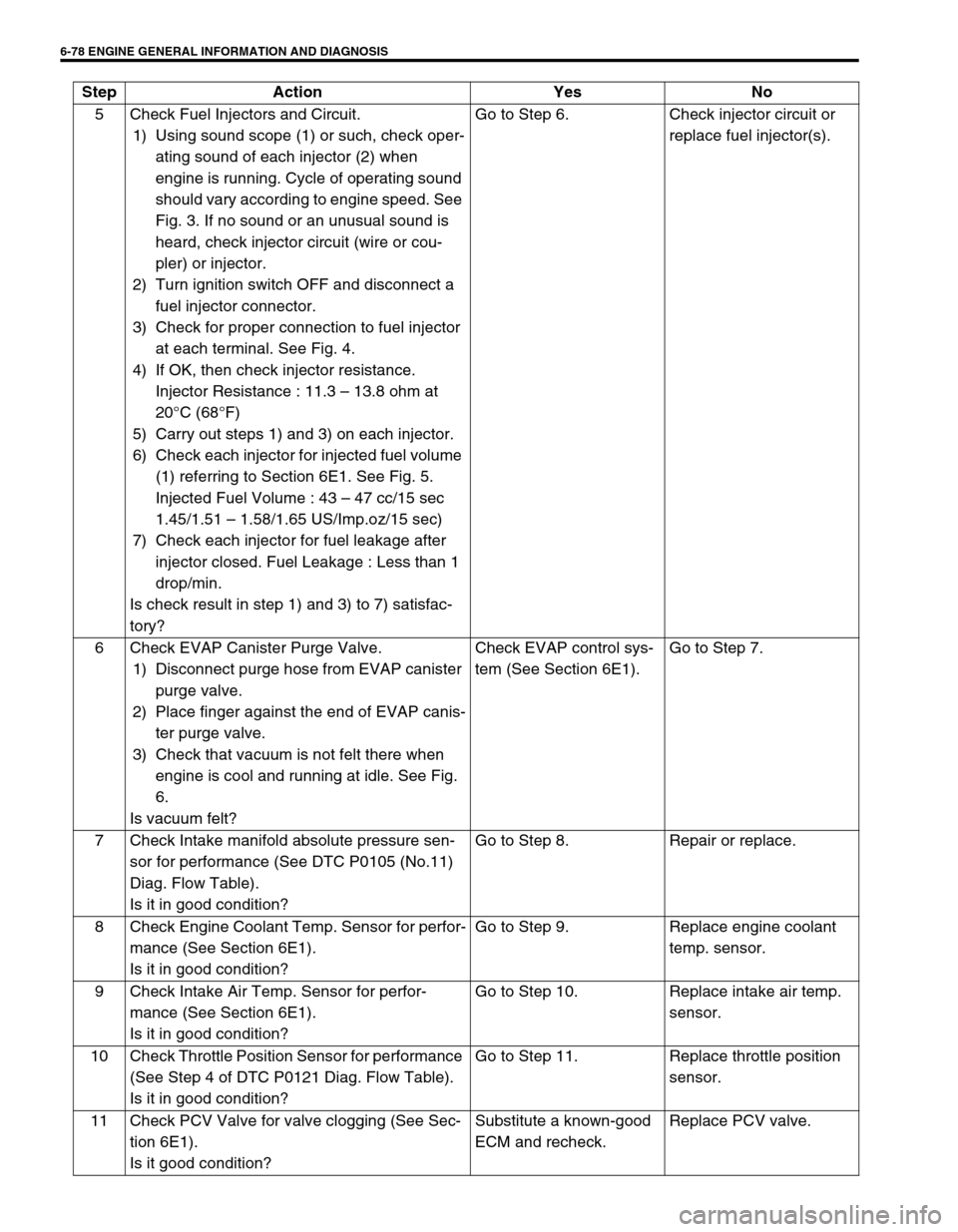
6-78 ENGINE GENERAL INFORMATION AND DIAGNOSIS
5 Check Fuel Injectors and Circuit.
1) Using sound scope (1) or such, check oper-
ating sound of each injector (2) when
engine is running. Cycle of operating sound
should vary according to engine speed. See
Fig. 3. If no sound or an unusual sound is
heard, check injector circuit (wire or cou-
pler) or injector.
2) Turn ignition switch OFF and disconnect a
fuel injector connector.
3) Check for proper connection to fuel injector
at each terminal. See Fig. 4.
4) If OK, then check injector resistance.
Injector Resistance : 11.3 – 13.8 ohm at
20°C (68°F)
5) Carry out steps 1) and 3) on each injector.
6) Check each injector for injected fuel volume
(1) referring to Section 6E1. See Fig. 5.
Injected Fuel Volume : 43 – 47 cc/15 sec
1.45/1.51 – 1.58/1.65 US/Imp.oz/15 sec)
7) Check each injector for fuel leakage after
injector closed. Fuel Leakage : Less than 1
drop/min.
Is check result in step 1) and 3) to 7) satisfac-
tory?Go to Step 6. Check injector circuit or
replace fuel injector(s).
6 Check EVAP Canister Purge Valve.
1) Disconnect purge hose from EVAP canister
purge valve.
2) Place finger against the end of EVAP canis-
ter purge valve.
3) Check that vacuum is not felt there when
engine is cool and running at idle. See Fig.
6.
Is vacuum felt?Check EVAP control sys-
tem (See Section 6E1).Go to Step 7.
7 Check Intake manifold absolute pressure sen-
sor for performance (See DTC P0105 (No.11)
Diag. Flow Table).
Is it in good condition?Go to Step 8. Repair or replace.
8 Check Engine Coolant Temp. Sensor for perfor-
mance (See Section 6E1).
Is it in good condition?Go to Step 9. Replace engine coolant
temp. sensor.
9 Check Intake Air Temp. Sensor for perfor-
mance (See Section 6E1).
Is it in good condition?Go to Step 10. Replace intake air temp.
sensor.
10 Check Throttle Position Sensor for performance
(See Step 4 of DTC P0121 Diag. Flow Table).
Is it in good condition?Go to Step 11. Replace throttle position
sensor.
11 Check PCV Valve for valve clogging (See Sec-
tion 6E1).
Is it good condition?Substitute a known-good
ECM and recheck.Replace PCV valve. Step Action Yes No